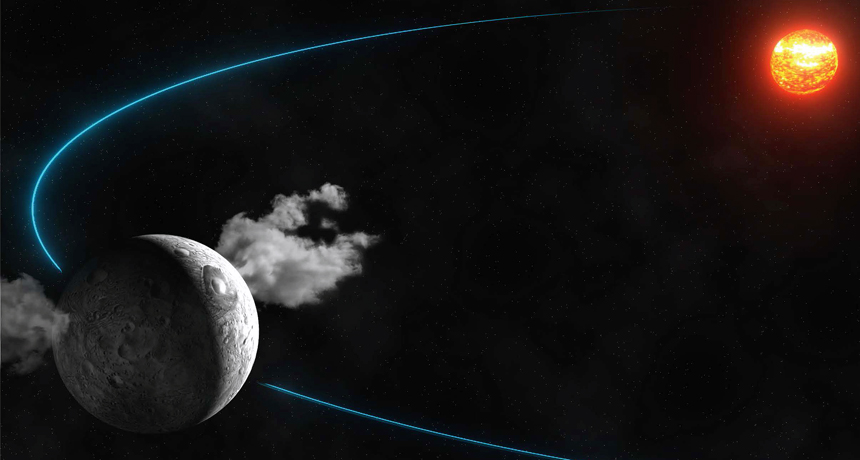Dwarf planet has water
Although expected, it was hard to confirm

Artist’s portrayal of water vapor being spewed by the dwarf planet Ceres.
IMCCE-Observatoire de Paris / CNRS / Y. Gominet, B. Carry
Ceres — the largest asteroid in the solar system — has water.
It’s not really a surprise. For three decades, astronomers have suspected that this “dwarf planet” might host water. But proving it was challenging. Michael Küppers with the European Space Agency (ESA) in Villanueva de la Cañada, Spain, and his colleagues now claim success.
The celestial body sits 270 million kilometers (nearly 168 million miles) from Earth in the asteroid belt between Mars and Jupiter. And Küppers’ team measured Ceres spewing at least 6 kilograms of water per second from two spots on its surface. It’s about 100 times more than scientists had been expecting. Both water-vapor sources are in mid-latitude regions. That means they are far from Ceres’ poles, which the astronomers note should be “where ice would be most stable.”
The researchers don’t know the source of the water but have some ideas. It could be ice that sort of vaporizes directly to a gas. Or — more provocatively — the water may be erupting from ice volcanoes. Like geysers, they would spew water, not the molten rock that Earth’s volcanoes do.
The researchers described their findings early (and online) Jan. 23 in the journal Nature.
Ceres’ vapors were confirmed with an instrument aboard ESA’s Herschel Space Observatory. It viewed the asteroid in far infrared light (wavelengths not visible to the unaided eye) on four occasions between late 2011 and early 2013. With the use of computer analyses, the researchers attempted to home in on the regions responsible for shedding most of the water vapor.
Confirming Ceres has water also supports the idea that icy bodies, such as comets, may have migrated into the asteroid belt as the solar system was forming.
Power Words
asteroid A rocky object in orbit around the sun. Most orbit in a region that falls between the orbits of Mars and Jupiter. Astronomers refer to this region as the asteroid belt.
astronomy The area of science that deals with celestial objects, space and the physical universe as a whole. People who work in this field are called astronomers.
dwarf planet One of the solar system’s small celestrial objects. Like a real planet, it orbits the sun. However, dwarf planets are too small to qualify as true planets. Prime examples of these objects: Pluto and Ceres.
solar system The eight major planets and their moons in orbit around the sun, together with smaller bodies in the form of dwarf planets, asteroids, meteoroids and comets.
volcano A place on Earth’s crust that opens, allowing magma and gases to spew out from the mantle. The magma rises through a system of pipes or channels, sometimes spending time in chambers where it bubbles with gas and undergoes chemical transformations. This plumbing system can become more complex over time. This can result in a change, over time, to the chemical composition of the lava as well. The surface around a volcano’s opening can grow into a mound or cone shape as successive eruptions send more lava onto the surface, where it cools into hard rock.
water vapor Water in its gaseous state, capable of being suspended in the air.







